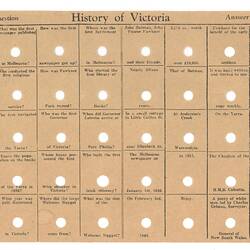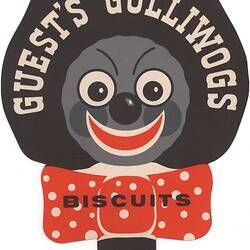Summary
Note: This object includes a derogatory depiction of a First Nations person. Such depictions are not condoned by Museums Victoria which considers them to be racist. Historical distance and context do not excuse or erase this fact. It also includes misleading historical content which denies First Peoples' sovereignty in Australia for more than 60,000 years.
Board game, 'Centenary AMUSU Electrical Game', 1933, manufactured in West Melbourne, by Impex Print & Cartoon Co. Orange and black box featuring painted image of a First Peoples man with spear, in front of image of city (meant to be Melbourne). The game is a grey cardboard board fitted with 40 metal contacts and a small light globe. Two electrical connectors - on insulated green and red wire respectively - are connected to the board. Two 'D' batteries hang off to the side.To play the game, the user places one of six sheets titled 'History of Victoria' (pierced with 40 holes corresponding to the metal contacts) on the board. A question is selected with one connector, then the answer is selected with the other connector. If correct, an electrical circuit is made, and the light shines.
The game reveals a particularly colonial approach to Australia's past with no recognitiion of First Peoples' sovereignty for over 60,000 years. This is demonstrated by such questions as: 'Who was the first white man to set foot on Victorian soil?', ''What can Victoria boast of' and 'When was the Yarra River first navigated?'.
The game's name may reference the Amusu cinemas which operated in Australia (Sydney, Perth and Maroubra, NSW) and in the United States (California, Texas, etc) at the time.
Physical Description
.1: Cardboard box, printed in orange and black. Features painted image of First Peoples man; in the background is the skyline of a city - meant to be Melbourne. .2: Grey cardboard game board fitted with 40 metal contacts and a small light globe. An insulated green wire extends from the top left corner of the board, terminating in a small metal plug. This wire is connected to two general purpose 'D'-sized batteries, which sit to the left of the board. A red insulated wire with metal plug has become detached and is stored with the game board. .3: Game board cover sheets. Six paper cover sheets (3 orange, 2 peach, 1 cream) to place over the electronic game board. Each sheet is divided into forty squares with a different question on the history of Victoria in each. Each square has been punched with a circular hole to accommodate metal contacts on the game board.
Significance
World War II changed life for everyone - including children. While fathers were away fighting 'Mr Hitler', many mothers worked long hours in offices and factories. Food and clothing were rationed, and children helped grow vegetables in backyard 'victory gardens'. After Japan entered the war in 1942 and invasion threatened, the fear of bombing hung in the air. Some city children were evacuated to rural areas. Many families built air-raid shelters in suburban backyards. Trenches were dug across school playgrounds, and air-raid drills were held. Yet wartime could be exciting, too. Military marches through the city streets, fireside games of strategy and battleships, and heroic tales of soldiers in far-off lands - all lit the imagination of many a Melbourne child. But reality hit hard for those children whose loved ones did not come home. (Melbourne Story exhibition label, 2008)
More Information
-
Collecting Areas
-
Acquisition Information
Purchase
-
Maker
Impex Print & Cartoon Co., Hawke Street, West Melbourne, Greater Melbourne, Victoria, Australia, 1933
-
Classification
-
Category
-
Discipline
-
Type of item
-
Dimensions
420 mm (Length), 202 mm (Width), 262 mm (Height)
Measurement From Conservation.
-
Keywords
Aboriginal Depictions, Celebrations, Education, Electrical Technology, Games, History of Melbourne, Melbourne Centenary, 1935, Victoria Centenary, 1934-1935, Cultural Stereotypes




